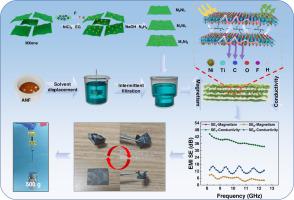电磁双梯度MXene@Ni/芳纶纳米纤维膜低反射电磁干扰屏蔽
IF 6.3
2区 材料科学
Q2 CHEMISTRY, PHYSICAL
引用次数: 0
摘要
低反射电磁干扰(EMI)屏蔽材料因其防止二次电磁污染的能力而受到越来越多的关注,但同时实现高EMI屏蔽效率(SE)和低反射仍然是一个主要挑战。在本研究中,首先合成了异质结构MXene@Ni杂化体,然后通过逐层真空辅助过滤工艺制备了具有电磁双梯度结构的多层MXene@Ni/ANF膜。通过精确控制MXene-to-Ni的加载比和特定的过滤顺序,实现了电磁双梯度结构。设计的梯度层状结构通过调节每个MXene@Ni/ANF层中MXene与Ni的质量比来调节电磁性能。因此,精确控制电磁梯度过渡层和反射层的复合膜实现了良好的阻抗匹配和电磁波耗散,最终获得了非常高效的EMI屏蔽性能(37.6 dB),具有低反射特性(低反射系数为0.72)。这种优化的结构确保了有效的电磁波吸收和最小的反射,使其非常适合先进的EMI屏蔽应用。本文章由计算机程序翻译,如有差异,请以英文原文为准。

Electro-magnetic dual-gradient MXene@Ni/Aramid nanofiber film for low-reflection electromagnetic interference shielding
Low-reflection electromagnetic interference (EMI) shielding materials have attracted increasing attention due to their capability to prevent secondary electromagnetic pollution, yet simultaneously achieving high EMI shielding effectiveness (SE) and low reflection remains a major challenge. In this study, heterostructure MXene@Ni hybrids were first synthesized, followed by the fabrication of a multilayered MXene@Ni/ANF film with an electro-magnetic dual-gradient structure via a layer-by-layer vacuum-assisted filtration process. The electro-magnetic dual-gradient structure was achieved by precisely controlling the MXene-to-Ni loading ratio and implementing a specific filtration sequence. The engineered gradient layered structure regulate the electromagnetic properties by modulating the mass ratio of MXene to Ni in each MXene@Ni/ANF layers. As a result, the composite film with precise control of the electro-magnetic gradient transition layers and reflection layer achieved excellent impedance matching and electromagnetic wave dissipation, ultimately resulting in remarkably efficient EMI shielding performance (37.6 dB) with low reflection characteristic (a low reflection coefficient of 0.72). This optimized structure ensures efficient electromagnetic wave absorption with minimal reflection, making it highly suitable for advanced EMI shielding applications.
求助全文
通过发布文献求助,成功后即可免费获取论文全文。
去求助
来源期刊

Surfaces and Interfaces
Chemistry-General Chemistry
CiteScore
8.50
自引率
6.50%
发文量
753
审稿时长
35 days
期刊介绍:
The aim of the journal is to provide a respectful outlet for ''sound science'' papers in all research areas on surfaces and interfaces. We define sound science papers as papers that describe new and well-executed research, but that do not necessarily provide brand new insights or are merely a description of research results.
Surfaces and Interfaces publishes research papers in all fields of surface science which may not always find the right home on first submission to our Elsevier sister journals (Applied Surface, Surface and Coatings Technology, Thin Solid Films)
 求助内容:
求助内容: 应助结果提醒方式:
应助结果提醒方式:


